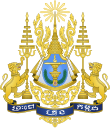Nation, Religion, King
Nation, Religion, King (Khmer: ជាតិ សាសនា ព្រះមហាក្សត្រ, UNGEGN: Chéatĕ, Sasânéa, Preăh Môhaksâtr, ALA-LC: Jāti, Sāsanā, Braḥ Mahāksatr; Thai: ชาติ ศาสนา พระมหากษัตริย์, RTGS: Chat, Satsana, Phra Mahakasat) is a motto and classic hendiatris which serves as an official motto of Cambodia and an unofficial motto in Thailand.
History
[edit]The Thai slogan, "Chat, Satsana, Phramahakasat" was created by Vajiravudh (Rama VI, 1910-1925) at the beginning of the 20th century.[1] It echoes La Nation, la Loi, le Roi (English: The Nation, the Law, the King) which was the national motto of France during the constitutional period of the French monarchy. After being educated at Sandhurst School during the rise of nationalism in Europe on the eve of World War I, the Thai King may have blended the modern Western concept of nationalism with the older indigenous symbols of kingship and Shangha to encourage loyalty to the nation.[2] During the 1930s Boworadet Rebellion, official propaganda modified the nationalist motto and believed that Nation, Religion, King and Constitution would be the four factors for Siamese unity and independence.[3]
The earliest record of this slogan in Cambodia appears in the preface to the Cultural Committee's serial of world lists carried in the Khmer-language Kambuja Suryia in 1949, but most decisively, Khmer novelist Nhok Them popularized the triad with a book entitled Nation, Religion, King in 1950. Nhok Them had studied in Thailand from 1918 to 1930 at the time of King Rama VI, maybe explaining the translation of the notion, although he never refers it to Thailand in his work.[4] By 1960, it had become a way to summarize the fundamental values of Cambodian culture which the Teacher Training Center in Kampong Kantuot made a short film entitled "The 3 Pillars of Cambodian strength: Church, Throne and Nation", with the support of the United States Information Service, inspired by a triad formulated by sinologisit Edward Harper Parker. [5]
From 1958 to 1963, Thai Army chief Sarit Thanarat suspended the constitution, dissolved parliament, and banned parties, using the motto Nation, Religion, King but adding, first and foremost, faithfulness to the government.[6] However, in the 1970s, the Thai extreme right-wing Buddhist and anti-communist Nawaphon organization saw itself as "the only group that [was] ready and able to defend the nation, the satsana, and the king."[7]
In 1984, in an attempt to explain this motto, David K. Wyatt referred to it as a "trinitarian mystery in which all three elements were inextricably bound together".[8]
Benedict Anderson compares it with the Shibboleth Orthodoxy, Autocracy, and Nationality, "an anticipatory strategy adopted by dominant dynastic groups which are threatened with marginalization or exclusion from an emerging nationally-imagined community".[9]
The Cambodian Constitution of December 1993 integrated Nation, Religion, King as the official motto of the restored monarchy in its fourth article. It in fact matched the "three constants of post-Angkorian Cambodian political history, namely, the Buddhist monarchy, the Theravada Sangha (community of monks), and the village-based society of ethnic lowland Khmer".[2]
Illustration
[edit]The Nation, Religion, King motto is often represented by the flags of Thailand and Cambodia.
In Cambodia, the motto is reflected in the order of the three national flags of Cambodia that must be raised in all public spaces as reminded in official government directives, with the national flag in the central most important position, then the Buddhist flag and finally the royal standard.[10]
More symbolically in Thailand, the colours of the flag of Thailand are said to stand for nation-religion-king, an unofficial motto of Thailand,[11] red for Thai ethnicity, white for religions and blue for the monarchy, the last having been the auspicious colour of Rama VI.
References
[edit]- ^ Harris, Ian (2008-03-11). Cambodian Buddhism: History and Practice. University of Hawaii Press. p. 295. ISBN 978-0-8248-3298-8.
- ^ a b Gyallay-Pap, Peter (2007). "RECONSTRUCTING THE CAMBODIAN POLITY: Buddhism, kingship and the quest for legitimacy". In Harris, Ian (ed.). Buddhism, Power and Political Order. Routledge. p. 72. doi:10.4324/9780203947494. ISBN 978-0-203-94749-4.
- ^ Barmé, Scot (1993). Luang Wichit Wathakan and the Creation of a Thai Identity. Institute of Southeast Asian Studies. p. 113. ISBN 978-981-3016-58-3.
- ^ Sasagawa, Hideo (April 2015). "Southeast Asian Studies, Vol. 4, No. 1, April 2015, pp. 43–72 43". Southeast Asian Studies. 4 (1). Kyoto University: 48.
- ^ Harper, Edward (1857). Perils of the throne, the Church, and the nation, an address.
- ^ Suksamran, Somboon (1981). "Religion, Politics and Development: The Thai Sangha's Role in National Development and Integration". Southeast Asian Journal of Social Science. 9 (1/2): 54–73. doi:10.1163/156853181X00048. ISSN 0303-8246. JSTOR 24490839.
- ^ Reynolds, Frank E. (1977). "Civic Religion and National Community in Thailand". The Journal of Asian Studies. 36 (2): 280. doi:10.2307/2053723. ISSN 0021-9118. JSTOR 2053723. S2CID 154861322.
- ^ Wyatt, David K. (1984). Thailand: A Short History. Yale University Press. p. 229. ISBN 978-974-07-5389-6.
- ^ Anderson, Benedict (1991) [1983]. Imagined Communities: Reflections on the Origin and Spread of Nationalism. London: Verso. p. 101. ISBN 0-86091-329-5.
- ^ សុខ មករា (2018-03-07). "សារាចរ ស្តីពីការប្រើទង់ជាតិ ទង់សាសនា និងទង់ព្រះមហាក្សត្រ ព្រមទាំងព្រះឆាយាល័ក្ខណ៍ព្រះអង្គទាំង៣" [Circular on the use of national flags, religious flags and royal flags]. រដ្ឋបាលខេត្តកំពង់ធំ.
- ^ "Thailand: A Country Study". Country Studies Program, formerly the Army Area Handbook Program, from the Library of Congress. Mongabay.com. Retrieved 23 July 2011.
Sarit revived the motto "Nation-Religion-King" as a fighting political slogan for his regime, which he characterized as combining the paternalism of the ancient Thai state and the benevolent ideals of Buddhism.
See also
[edit]- Orthodoxy, Autocracy, and Nationality – Ideological doctrine of Nicholas I of Russia


